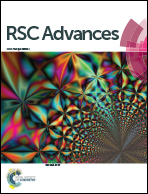Enhanced photocatalytic hydrogen evolution and ammonia sensitivity of double-heterojunction g-C3N4/TiO2/CuO†
Abstract
The performance of semiconductor photocatalysts has been limited by rapid electron–hole recombination. One strategy to overcome this problem is to construct a heterojunction structure to improve the survival rate of electrons. In this context, a novel g-C3N4/TiO2/CuO double-heterojunction photocatalyst was developed and characterized. Its photocatalytic activity for hydrogen production from water–methanol photocatalytic reforming was explored. Methanol is always used to eliminate semiconductor holes. The g-C3N4/TiO2/CuO double-heterojunction photocatalyst with a narrow bandgap of ∼1.38 eV presented excellent photocatalytic activity for hydrogen evolution (97.48 μmol (g h)−1) under visible light irradiation. Compared with g-C3N4/TiO2 and CuO/TiO2, the photocatalytic activity of g-C3N4/TiO2/CuO for hydrogen production was increased approximately 7.6 times and 1.8 times, respectively. Below 240 °C, the sensitivity of g-C3N4/TiO2/CuO to ammonia was approximately 90% and 46% higher than that of g-C3N4/TiO2 and CuO/TiO2, respectively. The enhancement of the photocatalytic activity and gas sensing properties of the g-C3N4/TiO2/CuO composite resulted from the close interface contact established by the double heterostructure. The trajectory of electrons in the double heterojunction conformed to the S-scheme. UV-vis, PL, and transient photocurrent characterization showed that the double heterostructure effectively inhibited the recombination of e−/h+ pairs and enhanced the migration of photogenerated electrons.



 Please wait while we load your content...
Please wait while we load your content...